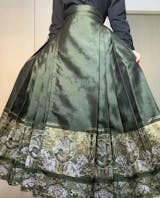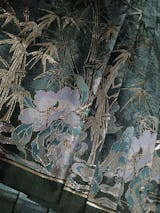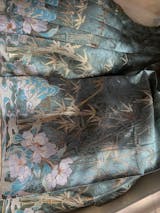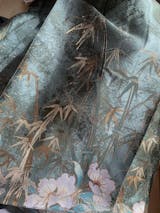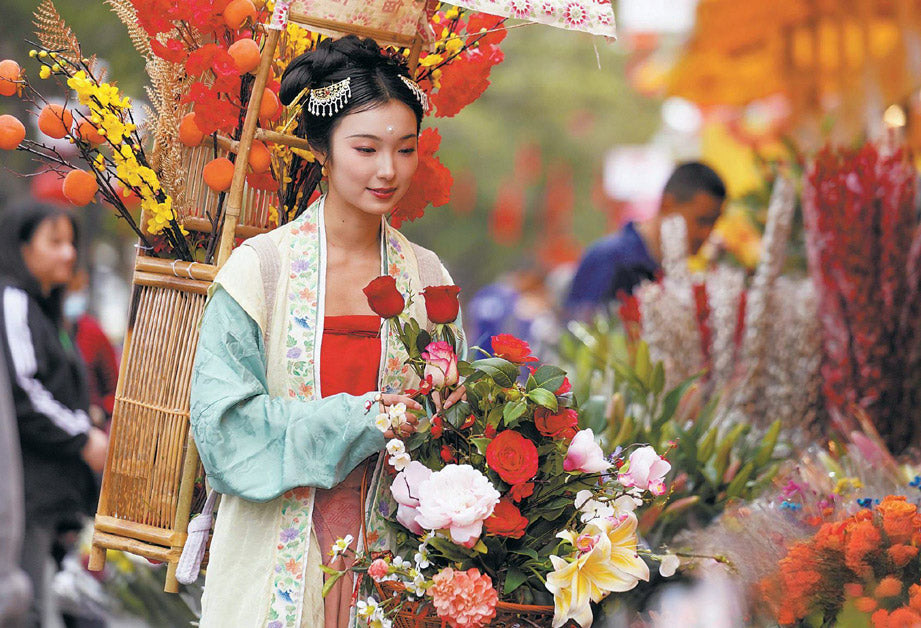
New Year Flowers: The Romantic Messenger of Spring Festival

In China, the Spring Festival is not just a holiday, it's a grand celebration filled with reunion, hope, and blessings. During this celebration, Nianxiao flowers, also known as New Year flowers, with their unique charm, become an indispensable part. Today, let us delve into the world of Nianxiao flowers, explore their origins, appreciate popular varieties, and feel the stories and emotions they carry.
The Origins of Nianxiao Flowers
The concept of Nianxiao flowers originated from the folk customs of Guangdong in the 1980s, originally referring to various flowers sold during the period from the Spring Festival to the Lantern Festival. People in Guangdong have the tradition of buying flowers for the New Year, mainly using peach blossom branches and kumquats as Nianxiao flowers, with a relatively narrow variety. However, over time, the range of Nianxiao flowers gradually expanded, and their sale period extended from just before the Spring Festival to cover Christmas, New Year's Day, the Spring Festival, and even Valentine's Day, collectively referred to as the Nianxiao period.
The history of celebrating the Spring Festival in China dates back to the early Western Zhou Dynasty, with over 4,000 years of history. Each year on this day of renewing and discarding the old, people decorate their homes with flowers and floral-themed decorations to enhance the festive atmosphere. These flowers are collectively known as "Nianhua" or Nianxiao flowers.
Due to China's vast territory and significant climatic differences between North and South, the choice of Nianxiao flowers has varied significantly throughout history. In the regions north of the Yangtze River, where the climate is colder, few flowers bloom during the Spring Festival, leading to the prevalence of plum blossom bonsai, orchid bonsai, and narcissus bonsai in noble households. In the Jianghuai region, flowers that bloom just before and after the Spring Festival, such as spring plum, wax plum, and narcissus, are used to decorate homes. In contrast, the climate in the Lingnan region during the Spring Festival is warm, creating a unique culture of Nianxiao flower markets.
Popular Varieties of Nianxiao Flowers
Nianxiao flowers bear the responsibility of "welcoming spring and inviting blessings." Especially close to the Lunar New Year, the fiery red blooms perfectly align with the festive atmosphere of the Chinese New Year. Flowers with auspicious meanings and vibrant colors become popular Nianxiao flowers used to greet the New Year. For instance, kumquat trees symbolize "great fortune and prosperity," longevity flowers embody longevity and auspiciousness, and lilies represent good fortune. Orchids are elegant and noble, amaryllis signifies good fortune and joy, hydrangeas symbolize hope and reunion, silver willow represents wealth, and butterfly orchids signify "prosperity and wealth." There are many such flowers, with common standards including good meanings, long blooming periods, festivity, and grandeur.
Currently, the Nianxiao flowers on the market primarily fall into two categories: imported and traditional Chinese. Each flower has its unique story and significance. Here are 15 common types of Nianxiao flowers.
1. Phalaenopsis (Butterfly Orchid)

Known as the "Queen of Orchids," the butterfly orchid derives its name from its butterfly-like shape. Its flower stems emerge from the leaf axils, slightly curved, bearing several blooms that resemble butterflies. The color range is vast, with red being predominant for Nianxiao flowers, appearing very festive. It symbolizes happiness, longevity, and abundance.
2. Cymbidium (Large Flower Orchid)

Loved for its magnificent and elegant posture, as well as its large flowers. Its strap-like leaves grow upright, and the vividly colored petals come in shades of yellow, white, green, red, pink, and various combinations, creating a grand and luxurious arch. The Cymbidium combines the fragrant elegance of domestic orchids with the vibrant colors of exotic species, holding high ornamental value and symbolizing abundance and peace.
3. Narcissus

Having a cultivation history of over a thousand years in China, narcissus is one of the most popular Nianxiao flowers. Its long, narrow strap-like leaves often bear fragrant yellow or white blooms. With its elegant and fragrant flowers making it particularly beloved during the Spring Festival, narcissus symbolizes auspiciousness, good fortune, beauty, purity, and longevity. It is commonly used as a New Year's flower or as part of the "year-round decorations" to beautify homes.
4. Auspicious Fruit (Firethorn Berries)

Known for its bright red berries that hang from its branches, auspicious fruit symbolizes a prosperous and auspicious year ahead. Placing a pot of it during the Spring Festival not only adds to the festive atmosphere but also signifies thriving family and career prospects in the new year.
Firethorn is particularly suitable for creating bonsai. Its leaves stay evergreen year-round, and its compact shape, coupled with lush foliage, makes it enjoyable for both viewing and tasting the fruit. A pot of firethorn planted indoors, bearing lots of its brightly colored fruit in winter, perfectly complements the joyous atmosphere of the Spring Festival. Its meanings include prosperity, auspiciousness, and abundance.
5. Fortune Seed (Cinnabar Root)

Also known as Cinnabar Root, the Fortune Seed features round, vibrant green leaves interspersed with clusters of bright red fruits, symbolizing abundance and blessings of many offspring. Not only is it aesthetically pleasing, but it also embodies people's good wishes for wealth and health in the upcoming year.
The fruits of the Fortune Seed start from green and later mature into a bright red color, making them very attractive. A pot of these small red fruits displayed in the living room looks festive, auspicious, and elegant. Additionally, Fortune Seed has a long fruiting period, allowing the bright red fruits to hang on the branches for quite a while, symbolizing wealth, good fortune, and plentiful blessings.
6. American Holly

Renowned for its unique feature of retaining berries in winter, the American holly's bright red fruits resemble little stars illuminating the silence of winter. It symbolizes resilience and brightness even amid adversity, making it an encouraging choice for families during the New Year. Strings of red, lantern-like berries hanging from the branches are tailor-made for the Spring Festival.
7. Forsythia (CunCunJin)

Named for its densely blooming golden-yellow flowers that resemble strings of gold coins, Forsythia is known for its vibrant color. It symbolizes an influx of wealth and continuous prosperity. Its lively appearance also signifies that the new year will bring smooth sailing and an abundance of good fortune.
8. Kumquat

The kumquat tree, with its golden fruits and lush green leaves, symbolizes abundance and good fortune. Placing kumquats during the Spring Festival not only beautifies the environment but also carries people's heartfelt wishes for increased wealth and a sweet life in the coming year.
Kumquats, which symbolize "great luck and fortune," is. a regular in Nianxiao flowers. The golden appearance of the fruits signifies wealth, and a tree full of these golden fruits looks especially festive and prosperous. Additionally, the word "jin" (金) means gold, while the "jv" (桔) in kumquat resembles the 'ji' (吉) in auspicious, meaning auspicious. Together, they signify good fortune and a bountiful source of wealth.
9. Golden Fruit (Five Generations Fruit)

Also known as Five Generations fruit, the Golden Fruit features plump, golden-yellow fruits that symbolize harmonious family living across five generations and the prosperity of the family. It is not only an ornamental delight but also serves as a symbol of family harmony and the happiness of having many descendants.
10. Buddha's Hand

With its uniquely shaped fruit resembling a hand, Buddha's Hand symbolizes wisdom, blessings, and longevity. Placing it at home enhances elegance and signifies health, longevity, and wisdom in the New Year.

Buddha's Hand was commonly placed on the desks of ancient scholars. Its refreshing fragrance not only alleviates stress but also nourishes the body and mind. Along with pomegranates and peaches, Buddha's Hand was one of the three favorite auspicious fruits of ancient times.
Buddha's Hand can be both a fruit and a flower, shifting from green to yellow, accompanied by a refreshing scent. It purifies the air, inhibits bacteria, and is excellent for placing in cars or indoors, creating a refreshing citrus atmosphere that's truly uplifting.
11. Anthurium (Red Palm Flower)

The bright red petals and unique shape of the anthurium make it a popular choice among Nianxiao flowers. It symbolizes passion and fortune, representing a successful career and continuous good luck in the New Year.
12. Amaryllis

Amaryllis is renowned for its large, vibrant flowers, typically in shades of fiery red or pink, symbolizing prosperity and romantic bliss. Displaying it during the Spring Festival brings warmth and vitality to the home.
13. Clivia

Clivia is cherished for its elegant posture and subtle fragrance. It symbolizes noble character and purity. Placing it in the home not only enhances the decor but also signifies the high moral standards and graceful lives of the family members.
14. Longevity Flower

Known for its long-lasting blossoms and dense flowers, longevity flower signifies health, longevity, and continuous blessings. Displaying longevity flowers during the Spring Festival reflects the best wishes for family members, hoping everyone enjoys enduring happiness and health.
15. Bougainvillea

Bougainvillea is widely popular for its vibrant colors and unique flower shapes. It symbolizes enthusiasm and resilience. Displaying it during the Spring Festival adds warmth and vitality to the home, signifying that family members will be full of positive energy and determination in the upcoming year.
Bougainvillea comes in a rich variety of species, with flowers in several colors, including red, pink, purple, white, and yellow. Some plants can even produce different colored flowers on the same specimen. The colors of different varieties vary greatly; some are as vivid as an oil painting, while others are fresh and unique, offering exceptional ornamental value. Bougainvillea can be shaped into cascading, upright, or spherical forms.
The Stories and Culture Behind Nianxiao Flowers

Nianxiao flowers beautify our environment while conveying the warmth and joy of the holiday season. Each flower has its unique story, they are more than just festive decorations—they embody cultural heritage.
For instance, the origin of the narcissus is a legend involving the daughters of Emperor Yao, Ehuang and Nvying. They married the same husband Shun, but when Shun died during a southern expedition, the daughters searched for him in vain, shedding tears on bamboo and rivers, thus transforming into narcissus. Therefore, this flower represents unwavering love.
The Clivia signifies "a gentleman's friendship is as light as water." Although its flowers are striking, they exhibit beauty in a restrained, subtle way. Just as a true gentleman, endowed with extraordinary talent and virtue, remains humble and discreet, Clivia is adored for its graceful elegance. Placing a pot in one's home during the Spring Festival not only enhances the festive atmosphere but also embodies aspirations for virtuous character and quality living.
Additionally, Nianxiao flowers are often used as gifts to friends and family, conveying goodwill and blessings. During the Spring Festival, gifting a pot of meaningful Nianxiao flowers expresses care, concern, and beautiful wishes for loved ones.

As a crucial part of traditional Chinese Spring Festival culture, Nianxiao flowers encompass people’s beautiful wishes for the New Year, transmitting warmth and joy through their fragrance. From the elegance of Phalaenopsis to the passion of Bougainvillea, from the freshness of narcissus to the dignity of Clivia, each Nianxiao flower carries unique charm and significance. During this hopeful and blessed time, let's appreciate these beautiful Nianxiao flowers, explore their historical and cultural backgrounds, and collectively welcome a vibrant and thriving Year of the [Yi-Si] Snake.


